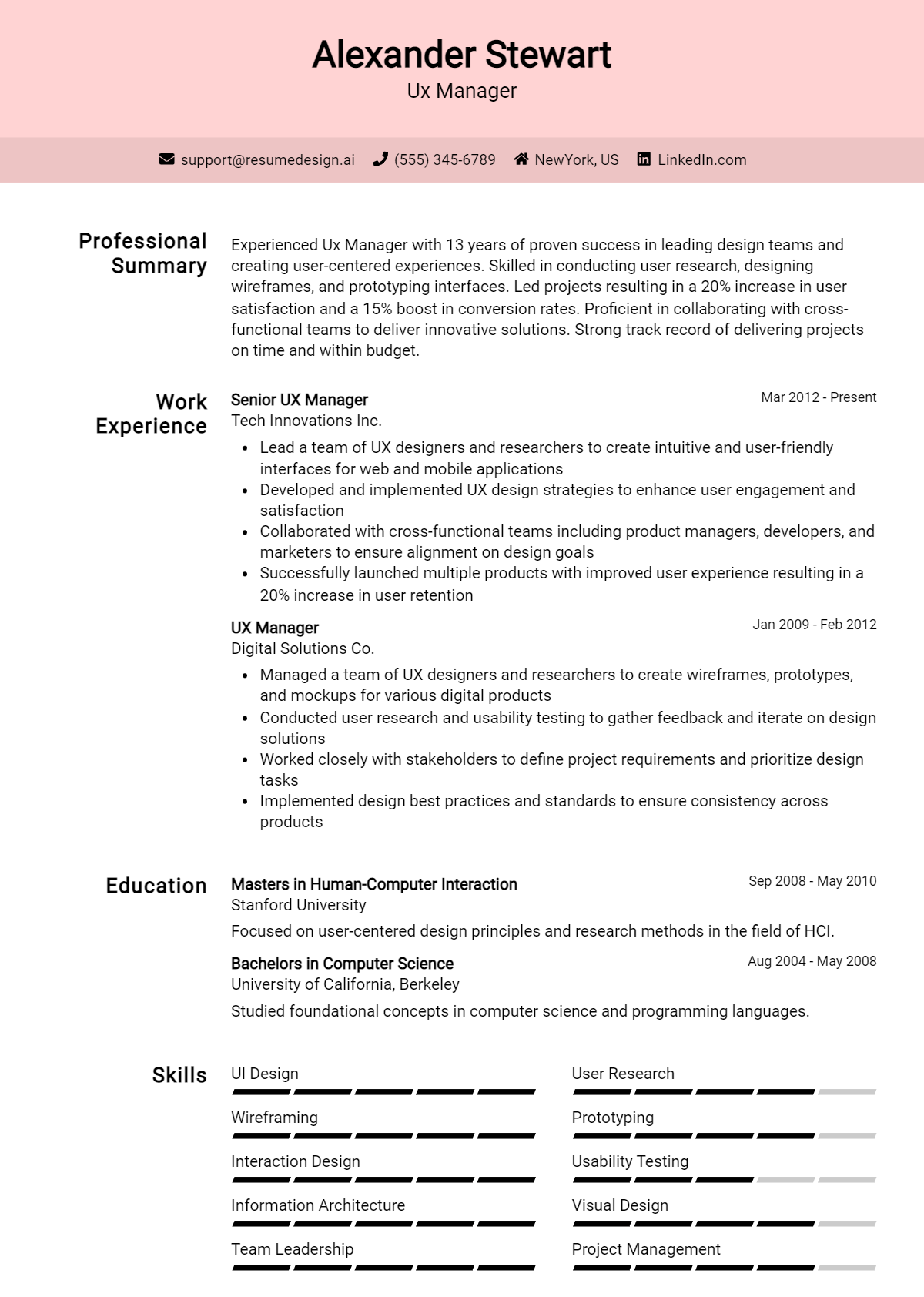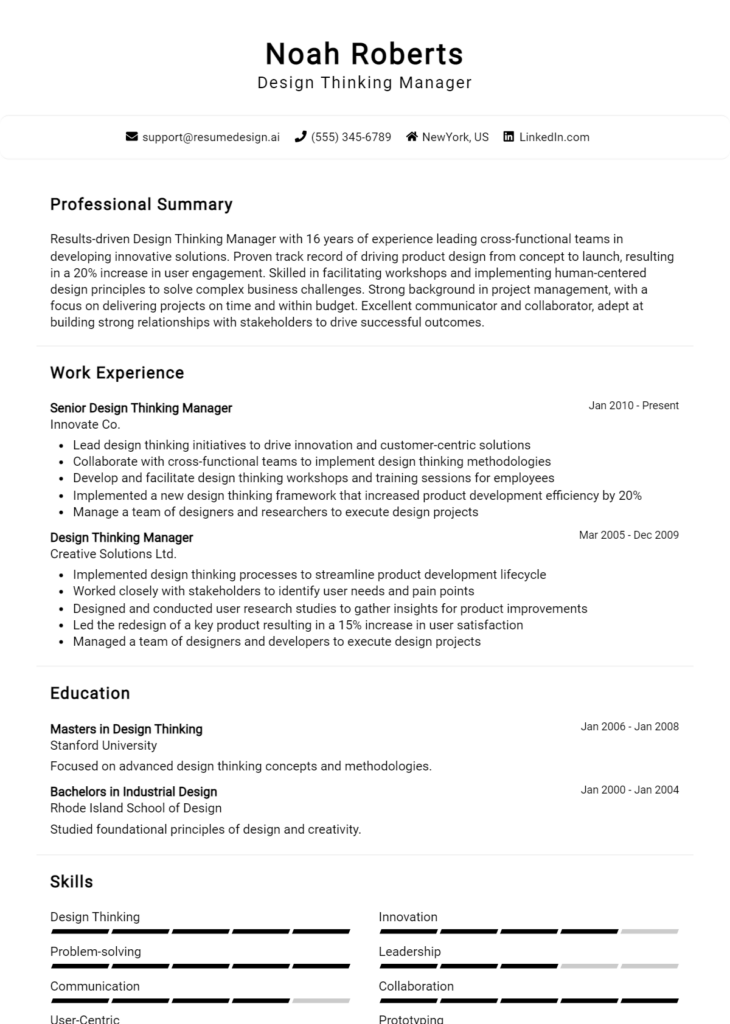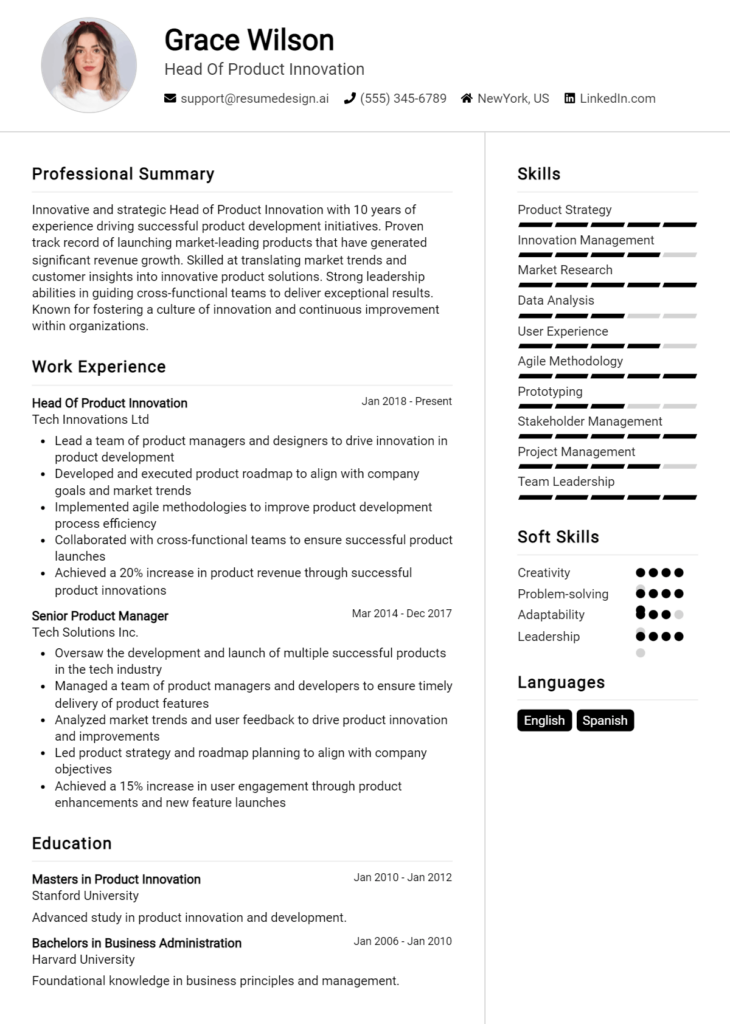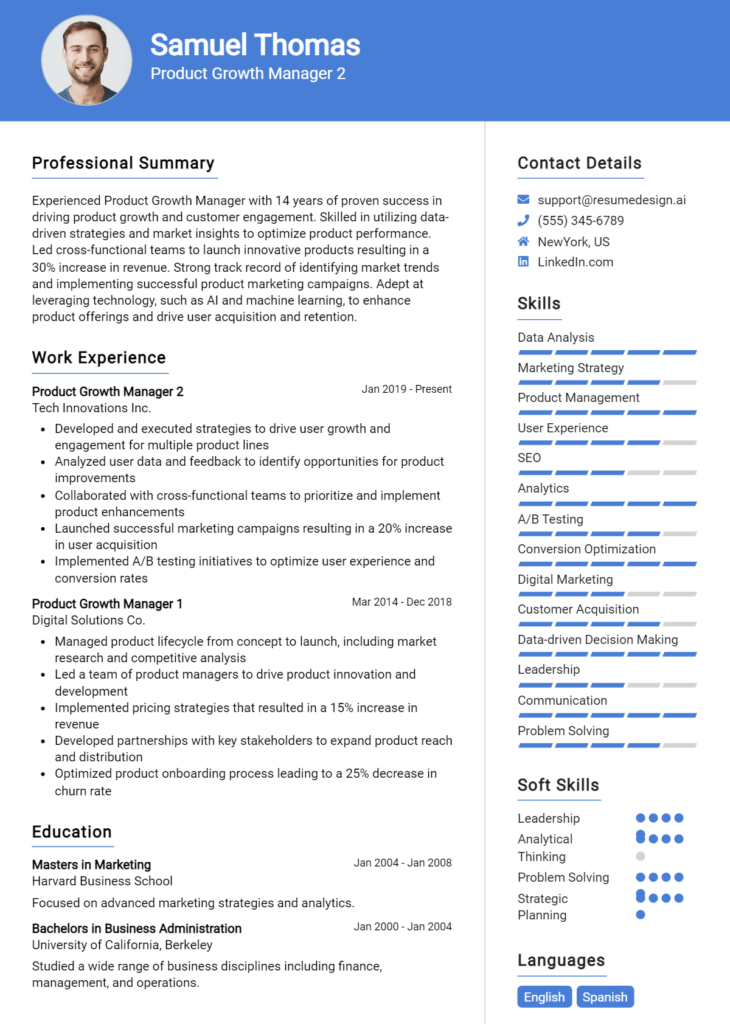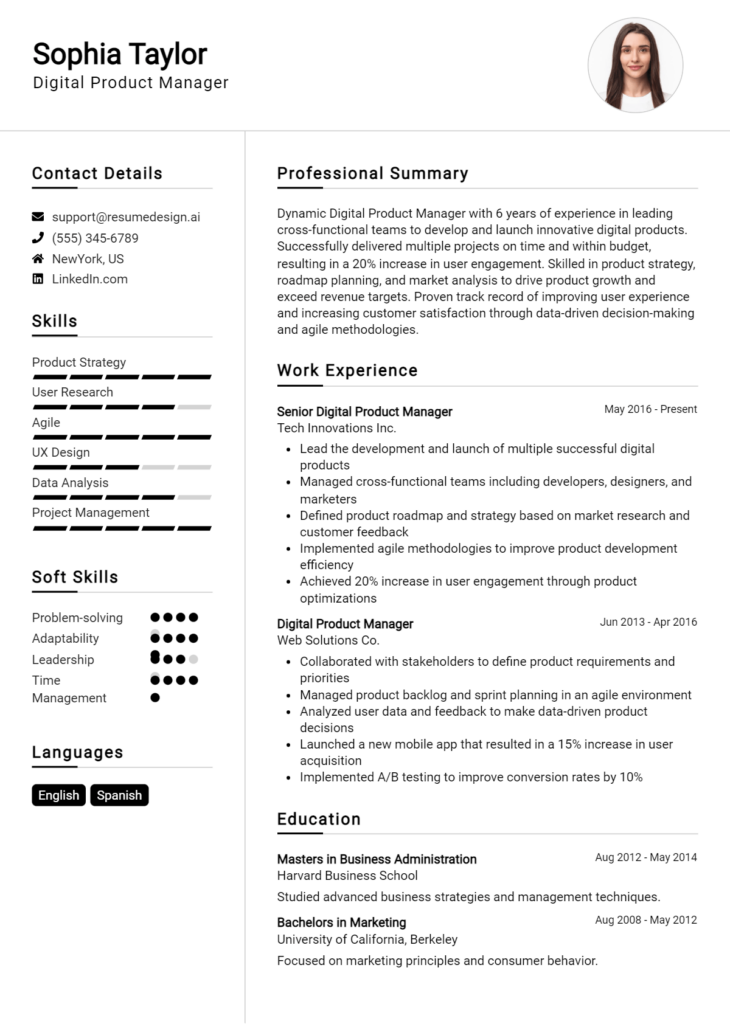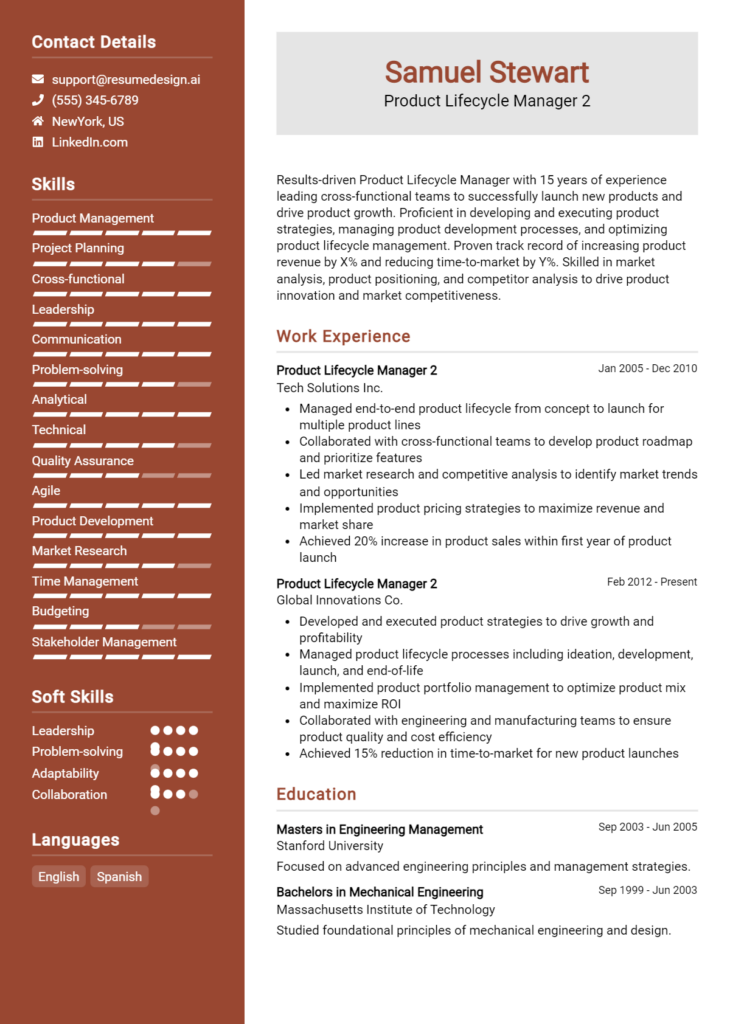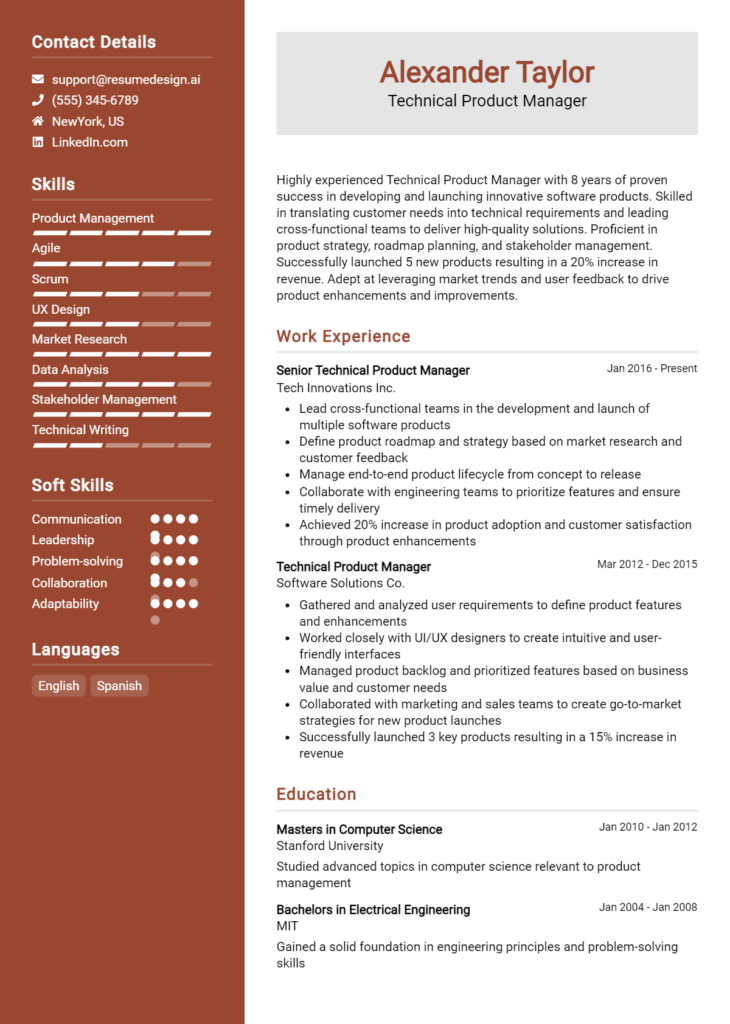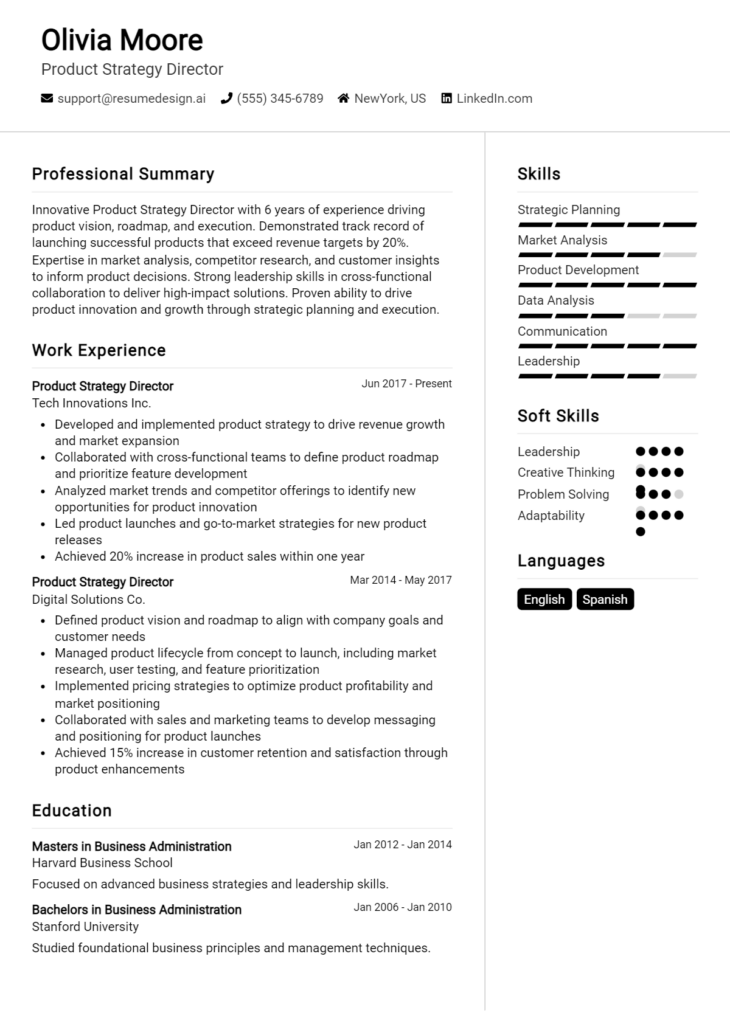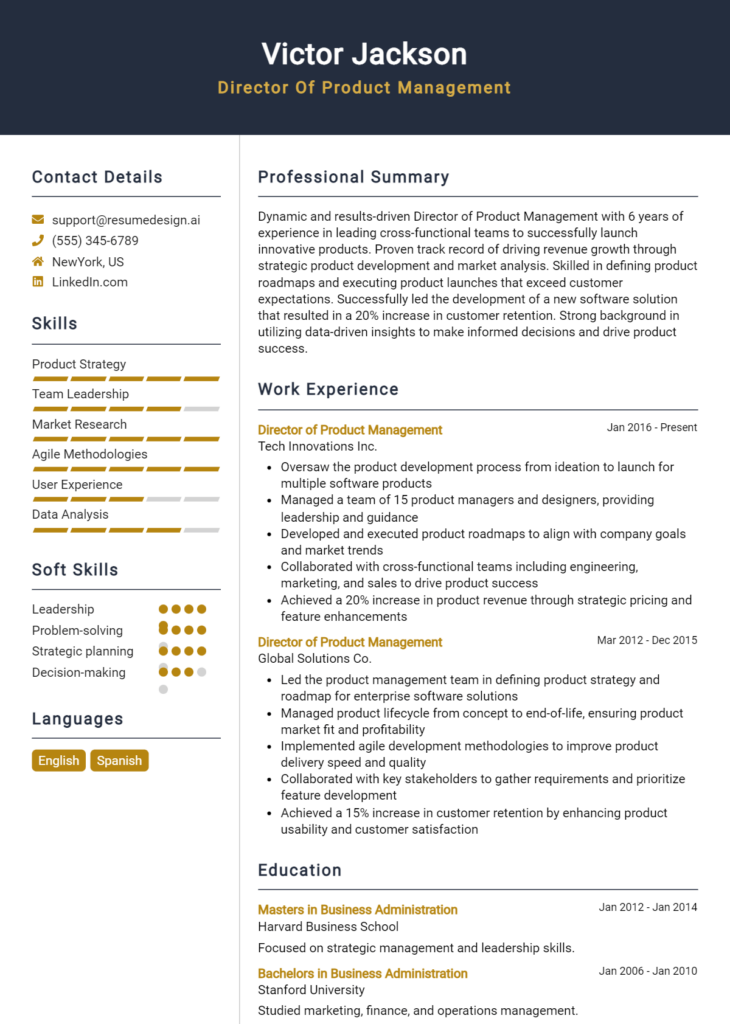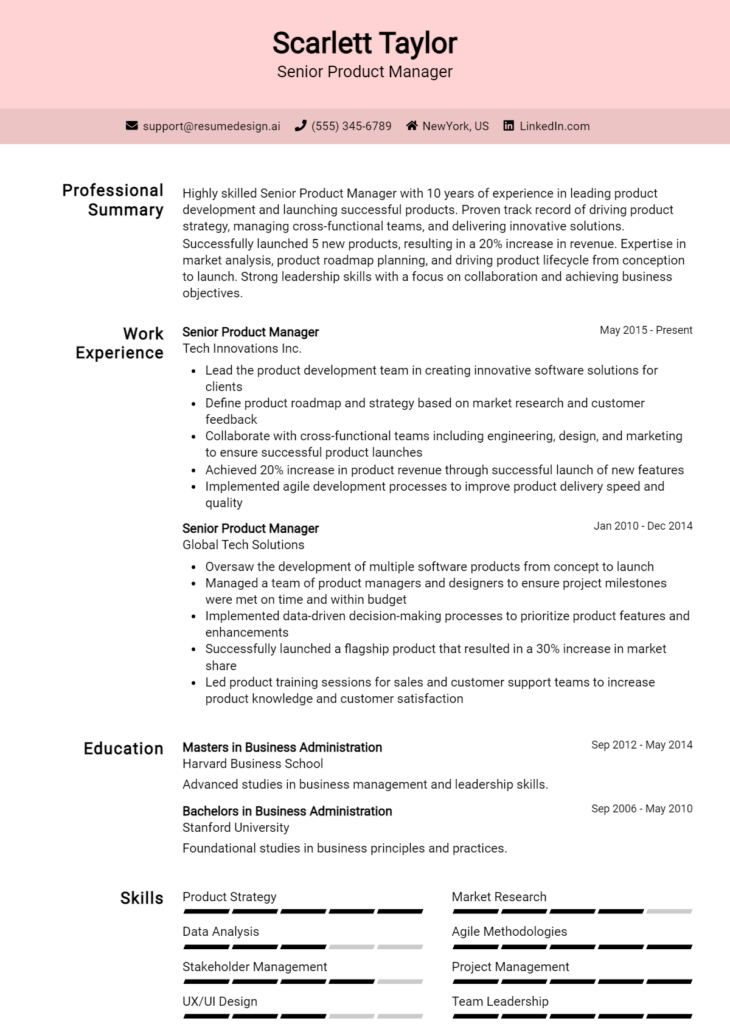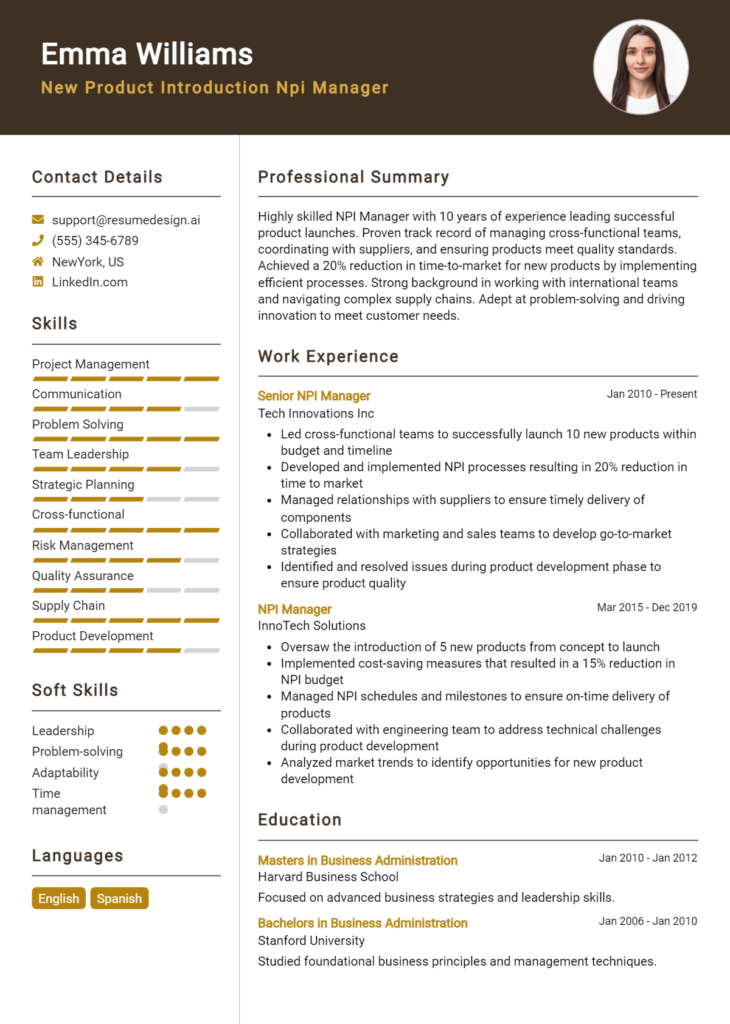UX Manager Core Responsibilities
A UX Manager plays a pivotal role in enhancing user experiences by bridging the gap between design, technology, and business strategy. Key responsibilities include leading UX research, overseeing design processes, and collaborating with cross-functional teams like marketing and development. Essential skills encompass technical proficiency in design tools, operational management, and advanced problem-solving abilities. These competencies contribute significantly to achieving organizational goals. A well-structured resume can effectively showcase these qualifications, making the candidate stand out in a competitive job market.
Common Responsibilities Listed on UX Manager Resume
- Lead and mentor UX design teams to produce innovative user experiences.
- Conduct user research and usability testing to gather insights.
- Collaborate with product managers and developers to align project goals.
- Define and implement UX design strategies and best practices.
- Analyze user feedback and behavior to inform design improvements.
- Present design concepts and user research findings to stakeholders.
- Oversee the creation of wireframes, prototypes, and user flows.
- Facilitate workshops and brainstorming sessions to drive creativity.
- Ensure consistency in design across all platforms and products.
- Stay updated with industry trends and emerging technologies.
- Measure and report on UX metrics to assess project performance.
- Advocate for user-centered design principles within the organization.
High-Level Resume Tips for UX Manager Professionals
In the competitive landscape of UX management, a well-crafted resume serves as the crucial first impression a candidate makes on potential employers. It is not merely a summary of work history; it should effectively showcase a blend of skills, achievements, and a deep understanding of user-centric design principles. A standout resume can set the stage for interviews, allowing candidates to narrate their professional stories and demonstrate their unique value. This guide will provide practical and actionable resume tips specifically tailored for UX Manager professionals, helping you to construct a document that resonates with hiring managers and reflects your expertise in the field.
Top Resume Tips for UX Manager Professionals
- Tailor your resume to the job description by using keywords and phrases that match the requirements and responsibilities outlined in the posting.
- Showcase relevant experience by highlighting past roles that directly relate to UX management, including specific projects you've led.
- Quantify your achievements with metrics and results, such as improved user engagement percentages or successful project completions within deadlines.
- Highlight industry-specific skills, such as user research methodologies, wireframing, prototyping tools, and familiarity with UX software.
- Include a summary statement that succinctly captures your professional identity and what you bring to the role of UX Manager.
- Demonstrate your leadership capabilities by describing how you have mentored teams and fostered collaboration within cross-functional groups.
- Incorporate a portfolio link that showcases your best UX work, including case studies that describe your design process and outcomes.
- Utilize a clean and organized layout that reflects your understanding of design principles, ensuring readability and visual appeal.
- Keep your resume concise, ideally one to two pages, focusing on the most relevant information and avoiding unnecessary jargon.
By implementing these tips, you can significantly enhance your resume, effectively increasing your chances of landing a job in the UX Manager field. A polished and tailored resume not only highlights your qualifications but also demonstrates your commitment to user experience principles, making you a strong candidate in the eyes of potential employers.
Why Resume Headlines & Titles are Important for UX Manager
In the competitive field of user experience design, a well-crafted resume headline or title is essential for a UX Manager. This brief yet powerful statement serves as the first impression for hiring managers, allowing them to quickly gauge a candidate's qualifications and expertise. A strong headline should encapsulate key skills and experiences in a concise manner, directly aligning with the job description. By doing so, it not only grabs attention but also provides a summary of what the candidate brings to the table, making it easier for recruiters to identify top talent amidst a sea of applicants.
Best Practices for Crafting Resume Headlines for UX Manager
- Keep it concise—aim for 10-15 words.
- Use industry-specific terminology relevant to UX design.
- Highlight key skills or accomplishments that set you apart.
- Incorporate metrics or results when possible to demonstrate impact.
- Ensure the headline aligns with the job description.
- Avoid buzzwords; instead, focus on clear, direct language.
- Tailor your headline for each application to reflect the specific role.
- Use action-oriented phrases to convey confidence and competence.
Example Resume Headlines for UX Manager
Strong Resume Headlines
"Innovative UX Manager with 10+ Years Driving User-Centric Design Solutions"
"Data-Driven UX Leader Specializing in Transforming User Feedback into Engaging Experiences"
“Award-Winning UX Manager Committed to Enhancing User Satisfaction and Accessibility”
Weak Resume Headlines
“Experienced Manager Looking for Opportunities”
“UX Professional”
Strong headlines are effective because they immediately convey the candidate's unique value proposition, making them memorable and relevant to the position. They highlight specific skills, experiences, or achievements that resonate with what hiring managers are looking for. In contrast, weak headlines lack specificity and fail to communicate the candidate’s strengths or relevance to the role, making them forgettable and less impactful in a competitive job market.
Writing an Exceptional UX Manager Resume Summary
A resume summary is a critical component for a UX Manager as it serves as the candidate's first impression to hiring managers. A strong summary quickly encapsulates key skills, relevant experience, and notable accomplishments that align with the job role, effectively grabbing the attention of the reader. It should be concise yet impactful, highlighting the candidate's unique value proposition while being tailored to the specific job they are applying for. A well-crafted summary not only sets the tone for the rest of the resume but also provides a compelling narrative that can differentiate a candidate in a competitive job market.
Best Practices for Writing a UX Manager Resume Summary
- Quantify Achievements: Use numbers and percentages to showcase your impact, such as increased user engagement or improved conversion rates.
- Focus on Relevant Skills: Highlight skills that are specifically mentioned in the job description, such as user research, prototyping, and design thinking.
- Tailor for the Job Description: Customize your summary for each application to align with the company’s goals and the specific requirements of the position.
- Keep It Concise: Aim for 3-5 sentences that deliver your message clearly without unnecessary jargon.
- Highlight Leadership Experience: If applicable, mention any team management or mentorship roles to demonstrate your capability in leading UX initiatives.
- Showcase Your Passion: Convey your enthusiasm for UX design and user-centered solutions to reflect your commitment to the field.
- Use Strong Action Verbs: Start with impactful verbs like 'led', 'developed', 'improved', or 'enhanced' to convey a sense of proactivity and achievement.
- Include Industry Keywords: Incorporate relevant terminology that hiring managers might be looking for to pass through applicant tracking systems.
Example UX Manager Resume Summaries
Strong Resume Summaries
Results-driven UX Manager with over 8 years of experience leading cross-functional teams in creating user-centric designs that increased customer satisfaction by 30%. Expert in conducting user research and usability testing to inform design decisions and enhance product functionality.
Dynamic UX Manager with a proven track record of launching successful digital products, resulting in a 25% boost in user engagement. Skilled in wireframing, prototyping, and collaborating with developers to deliver optimal user experiences that align with business objectives.
Innovative UX Manager specializing in transforming complex data into intuitive designs. Successfully led a project that improved the onboarding process, reducing user drop-off rates by 40% while increasing conversion rates by 15%.
Strategic UX Manager with 10+ years of experience in designing user interfaces for mobile and web applications. Recognized for improving user satisfaction scores by 20% through the implementation of user feedback loops and iterative design processes.
Weak Resume Summaries
Experienced UX professional looking for new opportunities. Good at design and working with teams.
UX Manager with various experiences in the field. Interested in developing user-friendly products and collaborating with others.
The strong resume summaries stand out because they include quantifiable achievements, specific skills, and a clear relevance to the UX Manager role. They demonstrate the candidate's impact through measurable results and articulate a focused narrative. Conversely, the weak summaries lack substance and specificity, failing to convey the candidate's unique skills or accomplishments, making them less compelling to hiring managers.
Work Experience Section for UX Manager Resume
The work experience section of a UX Manager resume is critical as it serves as a testament to the candidate's professional journey, showcasing their technical skills, leadership capabilities, and ability to deliver high-quality products. This section not only highlights the hands-on experience in UX design and management but also emphasizes the candidate's competence in leading teams to achieve user-centered design goals. By quantifying achievements and aligning experiences with industry standards, candidates can effectively demonstrate their value to potential employers and set themselves apart in a competitive job market.
Best Practices for UX Manager Work Experience
- Highlight relevant technical skills, including UX design tools and methodologies.
- Quantify achievements, such as improvements in user satisfaction scores or increased product adoption rates.
- Showcase leadership experience by describing team management, mentoring, or cross-functional collaboration.
- Use action verbs to convey impact and initiative, such as "led," "developed," or "optimized."
- Align work experience with industry standards and trends to demonstrate up-to-date knowledge.
- Include a variety of project types to illustrate versatility and adaptability in different UX contexts.
- Incorporate feedback from stakeholders to highlight collaboration and communication skills.
- Focus on the user impact of your work, emphasizing how your contributions benefited the end-user experience.
Example Work Experiences for UX Manager
Strong Experiences
- Led a cross-functional team of 10 designers and developers to redesign an e-commerce platform, resulting in a 30% increase in conversion rates over six months.
- Implemented a user research program that improved user satisfaction scores by 25% through iterative testing and feedback sessions.
- Managed the UX strategy for a mobile application, achieving a 40% increase in daily active users and a 50% reduction in user drop-off rate.
- Collaborated with product management to launch a new feature that drove a 15% increase in overall user engagement within three months.
Weak Experiences
- Worked on various projects with teams.
- Involved in user testing and design processes.
- Helped improve some features of existing products.
- Collaborated with other departments occasionally.
The examples are considered strong because they provide specific, quantifiable outcomes that demonstrate the candidate's impact on the business and showcase their technical leadership and collaboration skills. In contrast, the weak experiences lack detail and measurable results, making it difficult to assess the candidate's contributions or the significance of their role within the organization.
Education and Certifications Section for UX Manager Resume
The education and certifications section of a UX Manager resume plays a crucial role in establishing the candidate's credibility and expertise in the field. This section not only showcases the academic background but also highlights industry-relevant certifications and commitment to continuous learning. By detailing relevant coursework, specialized training, and recognized credentials, candidates can effectively demonstrate their alignment with the role and the skills required to succeed in a fast-evolving industry. A well-crafted education and certifications section can significantly enhance a candidate's profile, making them stand out among the competition.
Best Practices for UX Manager Education and Certifications
- Include only relevant degrees and certifications that pertain to UX design and management.
- Detail coursework that directly applies to user experience principles and methodologies.
- Highlight advanced degrees, such as a Master's in Human-Computer Interaction or User Experience Design.
- List certifications from recognized institutions, such as the Nielsen Norman Group or Interaction Design Foundation.
- Ensure the format is clear and easy to read, with consistent styling for institutions and dates.
- Update the section regularly to reflect new skills or certifications acquired through ongoing learning.
- Consider including relevant workshops or training sessions that enhance UX skills.
- Use action verbs to describe the impact of your education on your professional development.
Example Education and Certifications for UX Manager
Strong Examples
- M.A. in Human-Computer Interaction, University of Washington, 2020
- Certified UX Professional, Nielsen Norman Group, 2021
- Advanced UX Design Course, Interaction Design Foundation, 2022
- B.S. in Graphic Design, Rhode Island School of Design, 2018
Weak Examples
- B.A. in History, University of California, 2015
- Certification in Microsoft Office, 2019
- Online Course: Introduction to Photography, 2020
- High School Diploma, 2010
The strong examples listed above demonstrate relevant academic backgrounds and industry-recognized certifications that align with the requirements of a UX Manager role. These qualifications indicate a commitment to the field and a solid foundation in user experience principles. In contrast, the weak examples illustrate qualifications that are either outdated or irrelevant to UX, such as a degree in History or certifications unrelated to design and user experience. Presenting strong examples enhances a candidate's profile, while weak examples may detract from their overall appeal in the competitive job market.
Top Skills & Keywords for UX Manager Resume
As a UX Manager, possessing a diverse array of skills is paramount for not only crafting intuitive user experiences but also for leading a team effectively. A well-structured resume that highlights both hard and soft skills can significantly enhance a candidate's appeal to potential employers. These skills reflect the ability to understand user needs, collaborate with cross-functional teams, and drive design strategies that align with business goals. By showcasing a robust combination of these competencies, a UX Manager can demonstrate their capability to foster innovation and create impactful user-centered designs. For a deeper dive, explore the importance of skills and how to effectively present work experience on your resume.
Top Hard & Soft Skills for UX Manager
Soft Skills
- Leadership
- Communication
- Empathy
- Problem-solving
- Collaboration
- Time management
- Adaptability
- Critical thinking
- Mentoring
- Conflict resolution
- User advocacy
- Creativity
- Emotional intelligence
- Decision-making
- Negotiation
Hard Skills
- User research methodologies
- Wireframing and prototyping
- Interaction design
- Information architecture
- Usability testing
- Visual design principles
- HTML/CSS proficiency
- Analytics and data interpretation
- A/B testing
- Design thinking
- User journey mapping
- Accessibility standards
- Agile and Scrum methodologies
- Software proficiency (e.g., Sketch, Figma, Adobe XD)
- Front-end development basics
- Project management tools (e.g., JIRA, Trello)
Stand Out with a Winning UX Manager Cover Letter
Dear [Hiring Manager's Name],
I am excited to apply for the UX Manager position at [Company Name] as advertised on [where you found the job posting]. With over [X years] of experience in user experience design and management, I am confident in my ability to lead your team in creating impactful and user-centered solutions. My background in both UX research and design, coupled with my passion for fostering collaborative environments, makes me an ideal candidate for this role.
In my previous role at [Previous Company Name], I successfully managed a team of designers and researchers, where we developed innovative features that enhanced user engagement by [specific percentage or outcome]. I implemented a user-centered design process that involved rigorous research, usability testing, and continuous feedback loops. This approach not only improved our product’s usability but also significantly increased customer satisfaction. My ability to translate complex user insights into actionable design strategies has been a key driver in the success of the projects I have led.
I am particularly drawn to the opportunity at [Company Name] because of your commitment to [specific value or project of the company]. I believe that my strategic vision and hands-on experience in leading cross-functional teams can help elevate your user experience initiatives. I am eager to contribute to a culture of innovation and excellence that is clearly present in your organization. I look forward to the possibility of discussing how my skills and experiences align with the goals of [Company Name].
Thank you for considering my application. I hope to bring my expertise in user experience management to your team and contribute to creating exceptional user experiences that resonate with your audience. I look forward to the opportunity to discuss my application further.
Sincerely,
[Your Name]
[Your LinkedIn Profile or Portfolio]
[Your Contact Information]
Common Mistakes to Avoid in a UX Manager Resume
When crafting a resume for a UX Manager position, it’s crucial to present your skills and experiences effectively. However, many candidates fall into common traps that can undermine their chances of making a strong impression. Understanding these mistakes can help you refine your resume and highlight your qualifications. Below are some frequent pitfalls to avoid:
Lack of Focus on User-Centered Design: Failing to emphasize your user-centered design approach can make your resume seem generic. Highlight specific projects where you've prioritized user needs.
Using Jargon Without Context: While industry terminology can showcase your knowledge, excessive jargon can alienate readers. Always provide context to ensure clarity.
Not Quantifying Achievements: Simply listing responsibilities doesn't convey impact. Use metrics and data to illustrate how your contributions improved user experience or business outcomes.
Ignoring the Importance of Visual Design: As a UX Manager, your ability to communicate visually is vital. A cluttered or poorly organized resume can reflect negatively on your design skills.
Overloading with Information: Including too much information can overwhelm hiring managers. Focus on relevant experiences and curate your content to maintain clarity and impact.
Neglecting Tailoring for Specific Roles: Sending the same resume for different positions can be detrimental. Tailor your resume to highlight the skills and experiences most relevant to the specific job description.
Skipping Soft Skills: While technical skills are essential, don’t overlook the importance of soft skills like communication and collaboration. These are crucial for a managerial role.
Failing to Include a Portfolio Link: For UX positions, a portfolio is often as important as a resume. Failing to include a link to your portfolio can miss an opportunity to showcase your work.
Conclusion
As we conclude our exploration of the critical role of a UX Manager, it’s clear that this position demands a unique blend of skills, from user research and design to leadership and strategic vision. A successful UX Manager not only shapes the user experience but also advocates for the user within the organization, aligning design goals with business objectives.
Key responsibilities include leading design teams, conducting user research, collaborating with cross-functional teams, and ensuring the usability and accessibility of products. It’s essential for UX Managers to stay updated with industry trends and tools, continuously refining their approach to user-centered design.
Given the competitive nature of the UX field, having a polished and well-structured resume is crucial. We encourage you to review your UX Manager resume to ensure it highlights your relevant experience and skills effectively. To assist you in this process, we recommend utilizing various resources available:
- Explore resume templates that can help you structure your information clearly and attractively.
- Use the resume builder to create a customized resume tailored to your specific career goals.
- Check out resume examples for inspiration on how to present your accomplishments and skills.
- Don’t forget to craft a compelling first impression with our cover letter templates that complement your resume.
Take action today and ensure your resume reflects your expertise and stands out in the competitive UX landscape!

